Movies Beneath A Starry, Starry Night
The Jurong Drive-in was Singapore’s one and only drive-in cinema. In its heyday in the 1970s, it was packed bumper to bumper with vehicles. Sharon Teng tracks its rise and subsequent decline.
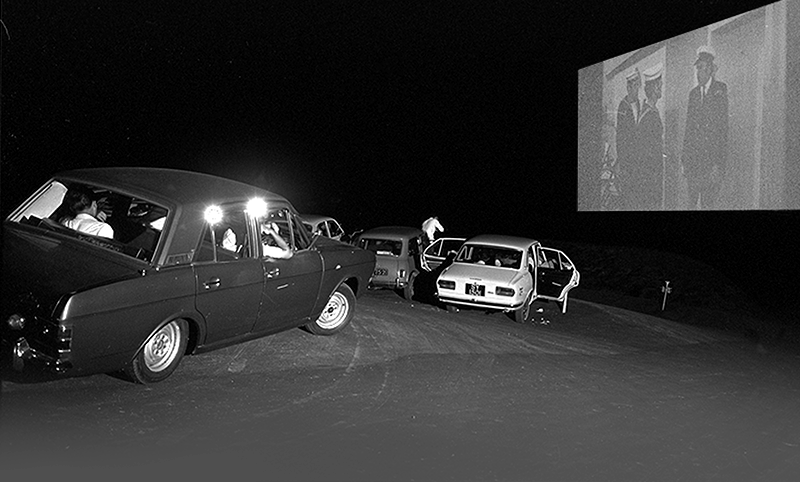
A drive-in cinema conjures up breezy fun, adventure and romance under the stars. Singapore’s one and only drive-in cinema, the former Jurong Drive-in, opened 50 years ago. It only lasted 15 years but during its short lifespan, it left indelible memories.
The Jurong Drive-in Cinema opened on 14 July 1971 and it was touted as the next “in-thing” that would revolutionise the movie-watching experience. Constructed at an estimated cost of $3 million, this was the first drive-in cinema in Singapore and Malaysia and also the largest in Asia at the time.
A full-page announcement was published in the Straits Times on the day of the cinema’s opening. In it, the Deputy Chairman of Cathay Organisation, Heah Hock Meng, wrote that the new drive-in promised that patrons would be treated to first-class movie entertainment and there would be “no parking problems, no parking fees; no need to worry about acoustics because every car will have its own speaker which can be adjusted to suit the patron’s needs”. In addition, patrons would not have to “worry about what you wear… [and if] the baby cries or your wife inadvertently drops her handbag with a clatter at a crucial moment in the film, you will get no hard looks because, of course, you have complete privacy in your own car”.1
Location and Amenities
The construction of Jurong Drive-in was no easy task. It occupied 14 acres (5.6 hectares) of land along Yuan Ching Road, adjacent to Jurong Park, at a site now occupied by ActiveSG Park @ Jurong Lake Gardens. The site required 340,000 cubic yards (259,939 cubic metres) of earth to fill in the landscaping just for the installation of the giant screen. Measuring a whopping 47 ft by 110 ft (14.3 m by 33.5 m) and suspended 25 feet (7.6 m) from the ground, the screen was also tilted at an angle of six-and-a-half degrees for optimal viewing from the inside of a car.
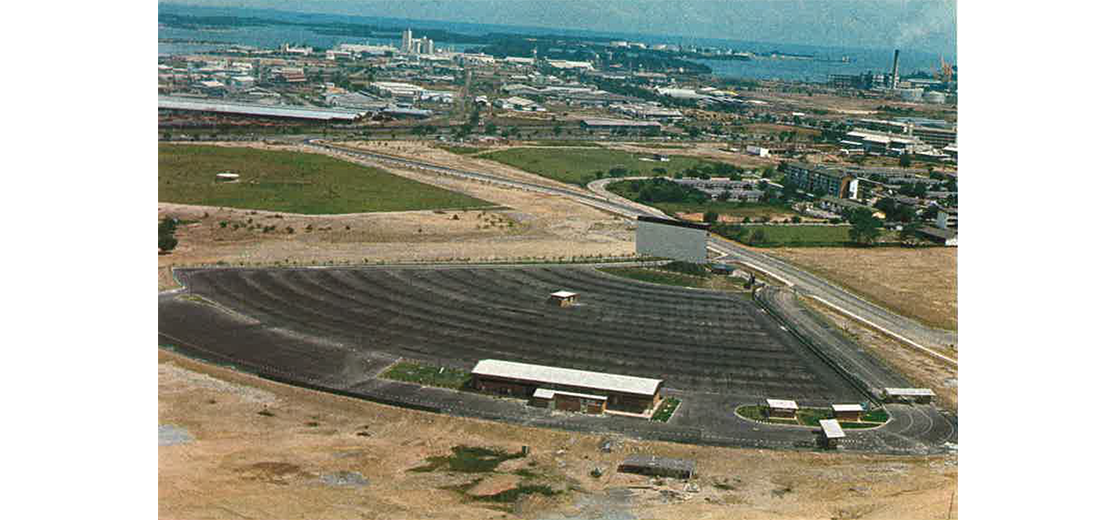
The sound system was supported by a projector that had a range of 275 ft (83.8 m) compared with 140 ft (42.6 m) for a typical indoor projector. Speakers were hooked onto either side of posts, one for each car. A car would park alongside a post, with the windscreen facing the cinema screen, and the speaker would be draped over the car window or door. Due to the terraced gradient, all cars enjoyed a clear and unobstructed view of the screen. Walk-in patrons could avail themselves to the 308-seat sheltered viewing gallery, which was installed with loudspeakers and fans.2
Ensuring the smooth entry and exit of vehicles from the cinema required careful planning. Cars coming from Jalan Ahmad Ibrahim would turn into Yuan Ching Road to reach the entrance of the drive-in. Car marshals were on hand to guide drivers to empty parking bays, particularly latecomers, to avoid dislodging those who had arrived earlier and were already in their chosen lots. There were two screenings each night – 7 pm and 9.30 pm – and cars arriving for the later show would wait in a large holding area that could accommodate 300 vehicles. As soon as the first screening ended and cars had vacated the lots, then the next lot of cars would be allowed to enter.3
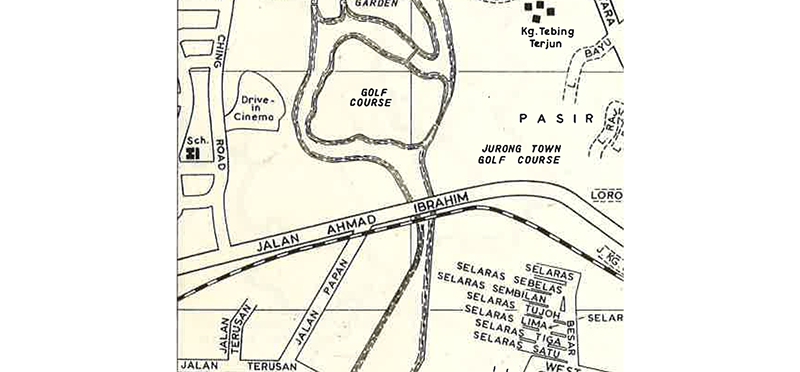
Vendors went around selling ice-cream and cold drinks which were snapped up, while an air-conditioned cafeteria offered quick bites like hamburgers, hot dogs, sandwiches, fried poh piah, chicken salad, porridge, mee siam, French fries and drumsticks.4There was even a playground containing a jungle gym, swings, slides, a merry-go-round and a rocker to occupy and entertain restless children.5 Eugene Ker Ban Hing, who used to sell newspapers at the entrance of the drive-in on weekends, recalled that “a pasar malam was held along the road leading to the drive-in [Yuen Ching Road] on Wednesday and Saturday nights, creating a carnival-like festive atmosphere”.6
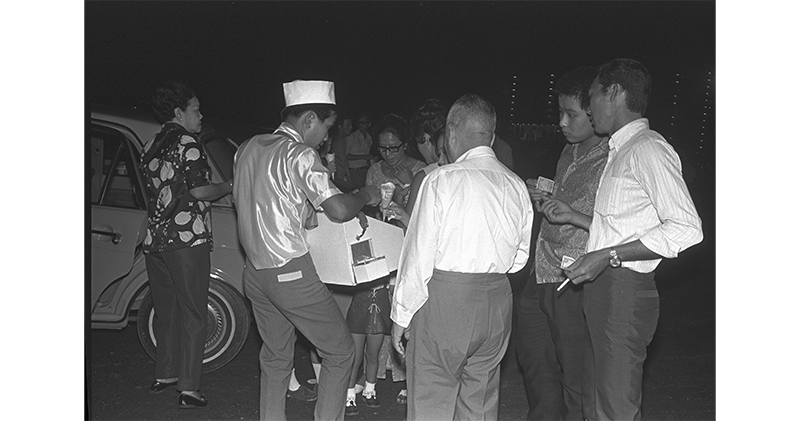
The Cinema Opens
On the opening night, 880 cars filled the 900-car capacity site. The film screened for the charity premiere was Doctor in Trouble, a British comedy set on a luxury cruise liner bound for the Mediterranean, with proceeds going to the Jurong Town Creche. Admission tickets were priced at $30 and $50 (for a reserved lot) per car for a maximum of five passengers, including the driver. An estimated $20,000 was collected that night.7
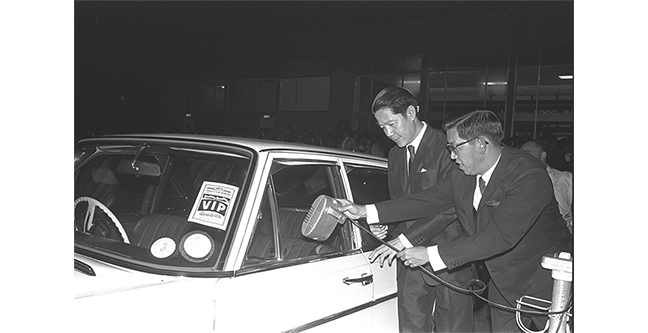
The cinema screened mainly first-run English language movies from the United States and Britain as well as Mandarin kungfu and action-packed films from Hong Kong, with two screenings each night and an additional midnight screening on Saturdays. Tickets cost $2 for adults and $1 for children below 12 (admission prices were later raised in 1978 to $2.50 for adults and $1.50 for children).8
Jurong Drive-in appealed to those who preferred the open air to the cramped interior of indoor cinemas as they could sit on stools outdoors, on their car roofs, on the back of their pick-up trucks or even lay newspapers on the ground. Children could run about in the open without disturbing their parents. Moreover, cinemagoers could be casually dressed in T-shirts, shorts and slippers.9
It was also popular with courting couples, who were perhaps less interested in the action taking place on the screen. Sales executive Felix Goh recalled going on a double date and there was some disagreement over seating arrangements. Even though sitting in front would provide a better view of the movie, it was the back seat that was in demand. “We tossed a coin over which couple should occupy the back seat. My friend won,” he quipped.10
For others, the journey to the far-flung cinema located in the western part of the island was itself a part of the experience. Hotel executive Lilian Gan reminisced, “My husband and I used to go there once or twice a week. We’d go on long drives on weekends and end up there.”11
Movies starring martial arts legend Bruce Lee were especially popular, packing in the crowds every night when these were screened. The Big Boss, which launched Lee’s movie career, was a spectacular box-office hit, raking in $12,000 in ticket sales for just an evening’s screening in 1971.12
Ronald Goh Wee Huat, who helped to install the sound system for the drive-in, recalled that on the opening night of The Big Boss, “the crowd was so overwhelming that the whole carpark slots, all the cinema, [were] all taken up and you have another few hundred cars along the road lining up. And you’re in the car and you’re stuck in that kind of jam, they just left the car there and actually broke through the fencing and there was chaos”. He also remembered that at the end of movie screenings, “a lot of times people drive off without removing the speakers and damaging their windscreens… some people brought a chain cutter and… took away the speaker”.13
Antoine Low, Head of Cathay’s Property and Technical Section, said that during a midnight screening of The Big Boss, there had been so many people and cars that they could not handle the flow. “We kept selling tickets and putting the steady flow of money into wastepaper baskets,” he recalled. As a result, the show, which had been scheduled for midnight, didn’t start till one in the morning.14
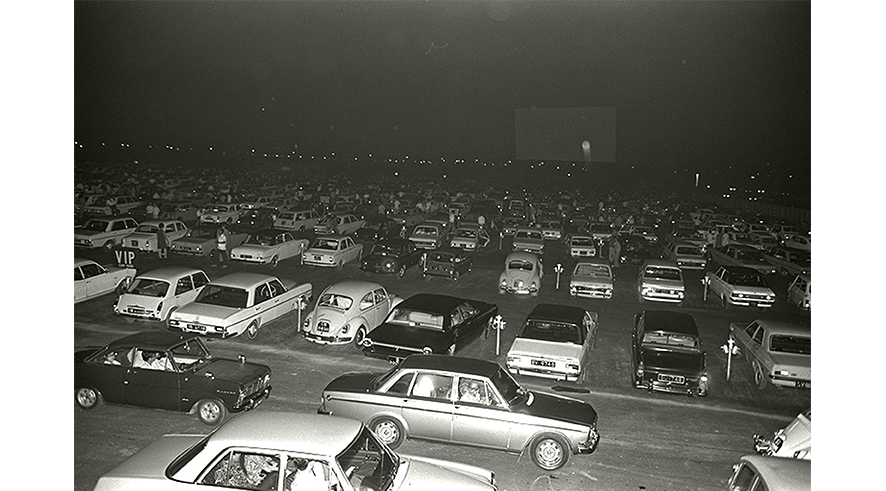
Some people even came up with ingenious ideas to avoid buying tickets. While working at a factory in Jurong, housing agent Teo Soon Kin said that he and his friends watched The Big Boss on five consecutive nights for free: “We sat outside the perimeter fence and watched. Sometimes, we would ask motorists nearest the fence to turn up the volume of their individual speakers so we could listen as well.”15
Cinema Shenanigans and Disgruntled Patrons
The Jurong Drive-in was, unfortunately, also a magnet for antisocial behaviour. In 1972, a reader wrote to the Straits Times complaining that “[b]efore the ending of each show at the Jurong Drive-in cinema, [especially during the weekends] ‘speed-aces’ with beam headlights on, exhaust booming and tyres screeching will be zooming at 40 to 50 m.p.h. along the lanes to see who reaches the exit first. It is not only an annoyance to others who wish to see the end of a film but also dangerous, to everyone in the drive-in”.16
These drivers also continued racing after leaving the drive-in and the writer suggested that the traffic police “arrest these speed-aces as they race each other along Upper Ayer Rajah Road”.17 A month later, the police replied that they had “taken enforcement action against 28 vehicles for speeding along Upper Ayer Rajah Road”.18
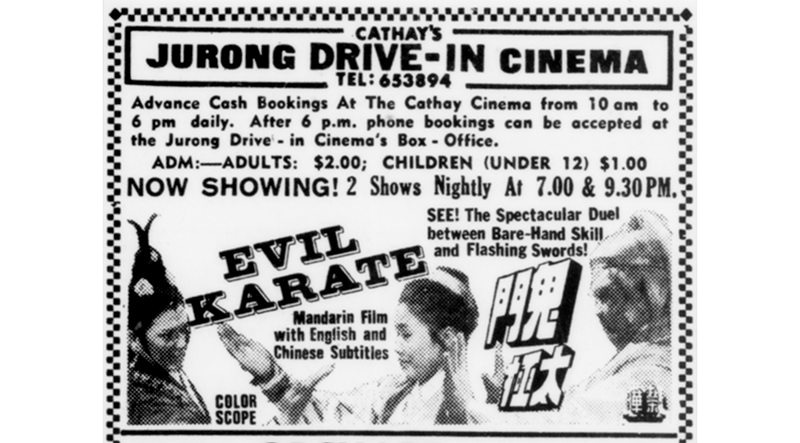
A decade on and things were no better. On 24 August 1982, a reader complained in the Straits Times that residents living near the Jurong Drive-in had been having sleepless nights on weekends and the eve of holidays. “Motorcyclists going for the midnight show make a din both before and after the show. The situation is worse when some of them turn the drive-in into a racing circuit before the show. The race lasts about twenty minutes and the noise is unbearable.”19 Once again, the police responded by mounting operations to monitor the situation, resulting in 84 motorcycles being impounded and 20 motorcyclists issued tickets for speeding, inconsiderate or dangerous driving.20
Just six months later, on 6 March 1983, the Singapore Monitor reported that “Jurong police are keeping a close watch on the Jurong Drive-In, because a group of hell-riders have been causing trouble there”. On the previous Saturday, more than 100 of them had ridden around the open-air cinema and were causing annoyance to other patrons. One cinemagoer said: “They dashed round the place in full throttle. Not only were the noise and fumes annoying, it was dangerous. Some of them also let off fireworks to add fun to their games, they looked so wild.”21
The huge amount of trash left behind by cinemagoers each night was also a concern as sweepers had to clear away the garbage before the following day’s screenings. Besides food wrappers, less common items found included footwear, condoms and even lingerie.22
There were also instances of break-ins and thefts at Jurong Drive-in, though not always competently done. On 3 May 1977, “eight masked youths armed with parangs and iron pipes broke into the restaurant and office of Jurong drive-in cinema. They earlier held up two security guards on rounds in the compound at 3 am and tied them with wire. After ransacking the premises for some time, they managed to get away with only a torchlight worth $5.25”.23
Waning Fortunes
Attendance at the Jurong Drive-in dropped drastically towards the end of the 1970s and early 80s. The manager of the drive-in, Peter Teo, lamented that “the novelty of the drive-in has worn off and we’d be extremely lucky if we got half the place full”.24
Said the New Nation: “Jurong is a bit out of the way, even for motorists. More comfortable and better cinemas are sprouting everywhere today, especially in HDB [Housing & Development Board] new towns and estates, showing much the same stuff as Jurong drive-in. Coming home from distant Jurong to a HDB carpark late at night and having to search every nook and corner for a lot can be a deterring experience.”25
In his oral history interview, former Jurong Drive-in employee Ronald Goh said: “I guess once the novelty wears off… the sound system is not so good, you have a small speaker… for serious cinemagoers, I don’t think they will enjoy the experience of going to the cinema. If you want to watch a proper movie, then with a proper sound system, of course, the theatre… It’s more for novelty, for dating teenagers that want to go to the cinema in a car and that’s it.”26
From the late 1970s, Cathay tried several methods to draw audiences in, such as distributing free gifts to children attending Walt Disney films at the drive-in, screening first-run English films and offering cheaper tickets than those sold at other cinemas. Unfortunately, Cathay was unsuccessful in reversing the trend.27
As early as 1980, Cathay was already considering shuttering the drive-in but decided to let it continue operating until the lease of the land (from the Jurong Town Corporation) on which it stood expired in 1985. On 10 December 1981, the Straits Times reported that “[at] the peak of [Jurong Drive-in’s] popularity in the early 1970s, it was fully packed every night, especially when it screened films of the late kung-fu star Bruce Lee. But once the novelty of Singapore’s only drive-in cinema wore off, nothing has been able to bring back the crowds. Today, only 100 cars are seen there on an average night, though weekends fare better”. A spokesman for Cathay Organisation said: “We have tried almost everything and have almost given up hope. The novelty of the drive-in seems to have faded.”28
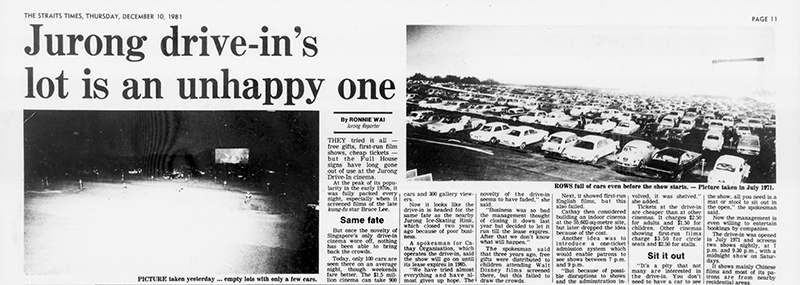
Cathay also blamed video pirates for poor attendance figures and the slump in the film industry. “Video pirates have been taking advantage of Singapore’s loose copyright laws. They have even been advertising their videotape rental services,” said Cathay spokesperson Geraldine Lee in 1985. According to Lee, about 200 people were going to the drive-in cinema for its two daily screenings and the situation was no better on weekends.29

On 29 September 1985, Cathay officially announced that Jurong Drive-in would close for good the following day, after its last show. The last movie screened was the Taiwanese film, The Woman of Wrath. The Straits Times described the dismal turn-up on 28 September: “The scene at the Jurong Drive-in Cinema last night. And it was a Saturday. On the screen was a Mandarin movie, The Woman of Wrath. But there were pathetically few patrons watching it. The gallery was almost deserted while only a few cars were found in its sprawling grounds.”30
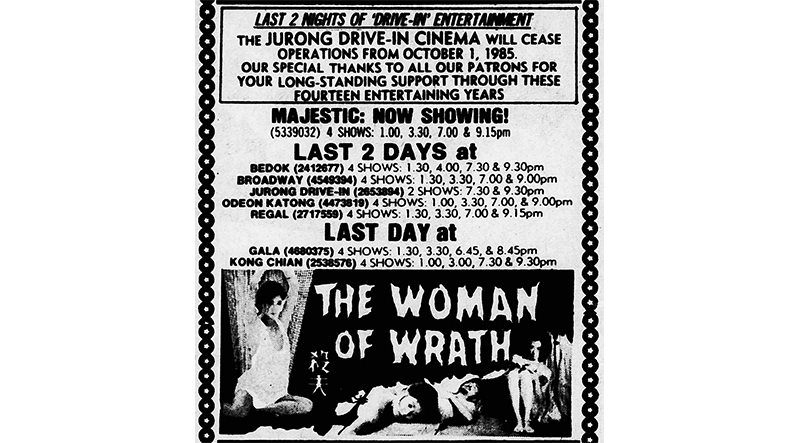
Jurong Drive-in finally closed on 30 September 1985 after almost 15 years.31 The land formerly occupied by the drive-in was developed into Fairway Country Club and later the ActiveSG Park in 2019 as part of Jurong Lake Gardens.32
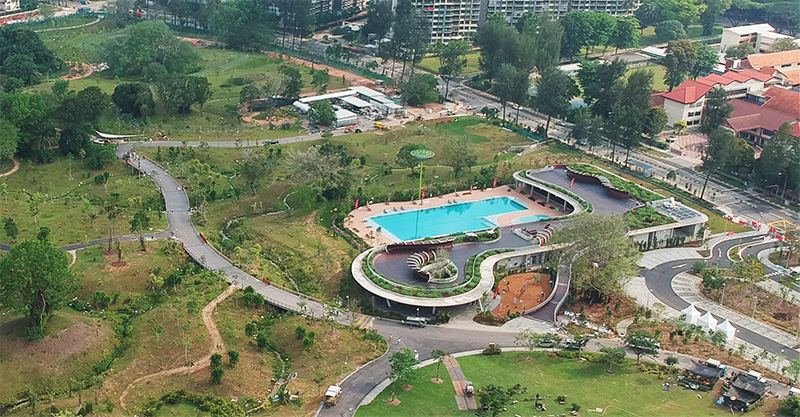
Revival of the Drive-in Cinema
There have been various attempts to revive the concept of the drive-in cinema in Singapore since.
At the 1996 Festival of the Arts, one of the programmes under the Arts Festival Fringe was a drive-in movie screening held at the People’s Association carpark in Paya Lebar, which had a capacity of 100 cars and 300 walk-in patrons. A projection screen, measuring 7 m by 3 m, was raised 2 m off the ground. Three family-friendly movies, including Grease and the animation film Asterix Conquers America, were screened back-to-back starting at 7.30 pm on 31 May and 1 June.33
In 2003, a drive-in movie screening was held at a carpark in Kallang as part of the month-long event, “Romancing Singapore”, which was organised to celebrate love and romance. The admission fee of $10 per car enabled patrons to watch two movies.34
Also in 2003, a company named MovieMob organised free drive-in and outdoor open-air movie screenings, including local films and Hollywood blockbusters, at selected locations across Singapore. Since its inception, the company has held over 300 movie screenings for events such as Singapore’s first French drive-in movie event over the Valentine’s Day weekend in 2016, “P.S. I Love You”, which attracted close to 100 vehicles and some 600 people. The company also helped to usher in the new year with open-air screenings of Night at the Museum I and II for the Marina Bay Singapore Countdown 2019.35
More recently, on 25 July 2020, Downtown East announced that it would hold a monthly series of drive-in movie screenings starting from 8 August with the hit musical, The Greatest Showman. Tickets were priced at $18 per car for up to a maximum of five persons in a vehicle. Unfortunately, just 10 days later, it was announced that the screening had been cancelled due to “unforeseen circumstances” and refunds would be made.36 We can only surmise that the cancellation was related to the ongoing Covid-19 pandemic.
As these examples demonstrate, there is still a market for the occasional drive-in movie experience. When mass events are allowed to take place again, hopefully some entrepreneurial company will resurrect the spirit of the Jurong Drive-in.
 Sharon Teng is a Librarian with the National Library, Singapore. She is part of the Arts and General Reference team, and manages the Social Sciences and Humanities Collection.
Sharon Teng is a Librarian with the National Library, Singapore. She is part of the Arts and General Reference team, and manages the Social Sciences and Humanities Collection.NOTES
-
“Cathay’s Jurong Drive-in Cinema,” Straits Times , 14 July 1971, 18. (From NewspaperSG) ↩
-
“Cathay’s Jurong Drive-in Cinema”; Lim Kay Tong, “Some Close Encounters at the Drive-in,” Straits Times, 18 December 1983, 9. (From NewspaperSG) ↩
-
“Cathay’s Jurong Drive-in Cinema”; “S’pore’s First Drive-in Cinema Opens in June,” Straits Times, 13 April 1971, 9. (From NewspaperSG) ↩
-
“Cathay’s Jurong Drive-in Cinema”; “Some Close Encounters at the Drive-in.” ↩
-
Eugene Ban Hing Ker, oral history interview by Teo Kian Giap, 20 December 2014, MP3 audio, Reel/Disc 1 of 20, 38:15. (From National Archives of Singapore, Accession no. 003963) ↩
-
Lim Kay Tong, Cathay: 55 Years of Cinema (Singapore: Landmark Books, 1991), 69. (From National Library, Singapore, Call no. RSING 791.43095957 LIM); “Cathay’s Jurong Drive-in Cinema”; Arthur Richards, “Drive-in off to a Funny Start,” Straits Times, 27 June 1971, 20; Nancy Byramji, “900 Cars at ‘Drive-in’,” Straits Times, 15 July 1971, 15; “Big Rush Daily to See Films at Drive-in Cinema,” Straits Times, 23 July 1971, 22. (From NewspaperSG) ↩
-
Lim, Cathay, 69; Jan Uhde and Yvonne Ng Uhde, Latent Images: Film in Singapore (Singapore: Oxford University Press, 2000), 198. (From National Library, Singapore, Call no. RSING 384.8095957 UHD); “Cathay’s Jurong Drive-in Cinema”; Ronnie Wai, “Jurong Drive-in’s Lot is an Unhappy One,” Straits Times, 10 December 1981, 11; Judith Hale, “‘We Won’t Make Much’,” New Nation, 29 March 1978, 2., (From NewspaperSG) ↩
-
Lito Gutierrez, “It’s Curtains for Jurong Drive-in Tomorrow,” Straits Times, 29 September 1985, 10. (From NewspaperSG); “Some Close Encounters at the Drive-in.” ↩
-
Lim, Cathay, 69; Uhde and Uhde, Latent Images, 198; “Jurong Drive-in’s Lot is an Unhappy one”; “Back Then When Jurong’s Drive-in Cinema was All the Rage,” Remember Singapore, 15 September 2020, https://remembersingapore.org/2020/09/15/jurong-drive-in-cinema-history/. ↩
-
Ronald Goh Wee Huat, oral history interview by Teo Kian Giap, 15 February 2013, transcript and MP3 audio, Reel/Disc 3 of 6. (From National Archives of Singapore, Accession no. 003790) ↩
-
J.W., “The Mad Scramble to Get Out First,” Straits Times, 24 October 1972, 8. (From NewspaperSG) ↩
-
“Untitled,” Straits Times, 24 November 1972, 21. (From NewspaperSG) ↩
-
Mid-Nightmare, “Too Noisy to Sleep,” Straits Times, 24 August 1982, 15. (From NewspaperSG) ↩
-
Yeow Shang Ying, “Action Taken at Drive-in,” Straits Times, 27 September 1982, 15. (From NewspaperSG) ↩
-
“Jurong Police Keeping Watch on Drive-in,” Singapore Monitor, 6 March 1983, 3. (From NewspaperSG) ↩
-
“Loot for 8 Armed Robbers: A Torchlight,” New Nation, 4 May 1977, 1. (From NewspaperSG) ↩
-
“End of Road for Drive-in?,” New Nation, 10 December 1982, 2. (From NewspaperSG); “Some Close Encounters at the Drive-in.” ↩
-
Ronald Goh Wee Huat, interview. ↩
-
“It’s Curtains for Jurong Drive-in Tomorrow”; “Dismay at Drive-in,” Straits Times, 29 September 1985, 1; “Page 4 Advertisements Column 2,” Straits Times, 29 September 1985, 4. (From NewspaperSG); “The Woman of Wrath,” Letterboxd, accessed 23 July 2021, https://letterboxd.com/film/the-woman-of-wrath/. ↩
-
Uhde and Uhde, Latent Images, 198; “It’s Curtains for Jurong Drive-in Tomorrow.” ↩
-
“Jurong Plans Cinema to Pull Crowds Back,” New Paper, 30 September 1989, 2. (From NewspaperSG); “Back Then When Jurong’s Drive-in Cinema Was All the Rage.” ↩
-
“Movie Bonuses at Fringe Fest,” Straits Times, 1 May 1996, 7. (From NewspaperSG) ↩
-
How Hwee Young, “Reliving the Good Old Days,” Straits Times, 23 February 2003, 4. (From NewspaperSG) ↩
-
“MovieMob,” Ape Works Pte Ltd, last modified 2019, https://www.ape.sg/moviemob.html; MovieMob, Facebook, 2020, https://www.facebook.com/apemoviemob; “Cycle & Carriage and Citroën Organise French Drive-in Movie,” Marketing Interactive, 15 February 2016, https://www.marketing-interactive.com/cycle-carriage-citroen-organise-french-drive-movie. ↩
-
Siti Hawa, “Drive-in Movie Screenings Available in S’pore for S$18 Per Car, Includes 2 Burgers & Drinks,” Mothership, 25 July 2020, https://mothership.sg/2020/07/downtown-east-drive-in-movie/; Belmont Lay, “Drive-in Movie Screening at Pasir Ris Downtown East on Aug. 8, 2020 Cancelled,” Mothership, 3 August 2020, https://mothership.sg/2020/08/pasir-ris-drive-in-movie-screennig-cancelled-downtown-east/. ↩

